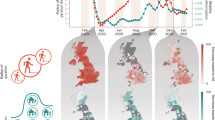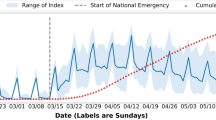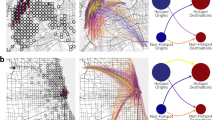Abstract
The urban spatial structure represents the distribution of public and private spaces in cities and how people move within them. Although it usually evolves slowly, it can change quickly during large-scale emergency events, as well as due to urban renewal in rapidly developing countries. Here we present an approach to delineate such urban dynamics in quasi-real time through a human mobility metric, the mobility centrality index ΔKS. As a case study, we tracked the urban dynamics of eleven Spanish cities during the COVID-19 pandemic. The results revealed that their structures became more monocentric during the lockdown in the first wave, but kept their regular spatial structures during the second wave. To provide a more comprehensive understanding of mobility from home, we also introduce a dimensionless metric, KSHBT, which measures the extent of home-based travel and provides statistical insights into the transmission of COVID-19. By utilizing individual mobility data, our metrics enable the detection of changes in the urban spatial structure.
This is a preview of subscription content, access via your institution
Access options
Access Nature and 54 other Nature Portfolio journals
Get Nature+, our best-value online-access subscription
$29.99 / 30 days
cancel any time
Subscribe to this journal
Receive 12 digital issues and online access to articles
$99.00 per year
only $8.25 per issue
Buy this article
- Purchase on Springer Link
- Instant access to full article PDF
Prices may be subject to local taxes which are calculated during checkout




Similar content being viewed by others
Data availability
All data needed to evaluate the conclusions in the paper are described in the paper and the Supplementary Information. For contractual and privacy reasons, we cannot make the raw mobile-phone data available. One can contract Kido Dynamics SA to try to get access to the raw mobile-phone data. A sample of the data is available in ref. 50. Source data are provided with this paper.
Code availability
The implementation of this work is available at GitHub (https://github.com/humnetlab/Urban_Dynamics) and Zenodo51.
References
Bettencourt, L. M. The origins of scaling in cities. Science 340, 1438–1441 (2013).
Batty, M. A theory of city size. Science 340, 1418–1419 (2013).
Batty, M. The size, scale and shape of cities. Science 319, 769–771 (2008).
Keuschnigg, M., Mutgan, S. & Hedström, P. Urban scaling and the regional divide. Sci. Adv. 5, eaav0042 (2019).
Xu, Y., Olmos, L. E., Abbar, S. & González, M. C. Deconstructing laws of accessibility and facility distribution in cities. Sci. Adv. 6, eabb4112 (2020).
Bertaud, A. The Spatial Organization of Cities: Deliberate Outcome or Unforeseen Consequence? IURD Working Paper 2004-01 (Univ. California, 2004).
Bettencourt, L. M., Lobo, J., Helbing, D., Kühnert, C. & West, G. B. Growth, innovation, scaling and the pace of life in cities. Proc. Natl Acad. Sci. USA 104, 7301–7306 (2007).
Ewing, R. & Rong, F. The impact of urban form on U.S. residential energy use. Housing Policy Debate 19, 1–30 (2008).
Lamsal, L., Martin, R., Parrish, D. & Krotkov, N. Scaling relationship for NO2 pollution and urban population size: a satellite perspective. Environ. Sci. Technol. 47, 7855–7861 (2013).
Li, D. et al. Urban heat island: aerodynamics or imperviousness? Sci. Adv. 5, eaau4299 (2019).
Anderson, W. P., Kanaroglou, P. S. & Miller, E. J. Urban form, energy and the environment: a review of issues, evidence and policy. Urban Studies 33, 7–35 (1996).
Tsekeris, T. & Geroliminis, N. City size, network structure and traffic congestion. J. Urban Econ. 76, 1–14 (2013).
Kaza, N. Urban form and transportation energy consumption. Energy Policy 136, 111049 (2020).
Clark, C. Urban population densities. J. R. Stat. Soc. A (Gen.) 114, 490–496 (1951).
Bertaud, A. & Malpezzi, S. The Spatial Distribution of Population in 48 World Cities: Implications for Economies in Transition, 54–55 (The Center for Urban Land Economics Research, Univ. Wisconsin, 2003).
Pereira, R. H. M., Nadalin, V., Monasterio, L. & Albuquerque, P. H. Urban centrality: a simple index. Geogr. Anal. 45, 77–89 (2013).
Sohn, J. Are commuting patterns a good indicator of urban spatial structure? J. Transport Geogr. 13, 306–317 (2005).
Acosta, R. J., Kishore, N., Irizarry, R. A. & Buckee, C. O. Quantifying the dynamics of migration after Hurricane Maria in Puerto Rico. Proc. Natl Acad. Sci. USA 117, 32772–32778 (2020).
Calabrese, F., Ferrari, L. & Blondel, V. D. Urban sensing using mobile phone network data: a survey of research. ACM Comput. Surveys 47, 1–20 (2014).
Olmos, L. E., Çolak, S., Shafiei, S., Saberi, M. & González, M. C. Macroscopic dynamics and the collapse of urban traffic. Proc. Natl Acad. Sci. USA 115, 12654–12661 (2018).
Xu, Y., Çolak, S., Kara, E. C., Moura, S. J. & González, M. C. Planning for electric vehicle needs by coupling charging profiles with urban mobility. Nat. Energy 3, 484–493 (2018).
Grantz, K. H. et al. The use of mobile phone data to inform analysis of COVID-19 pandemic epidemiology. Nat. Commun. 11, 4961 (2020).
Oliver, N. et al. Mobile phone data for informing public health actions across the COVID-19 pandemic life cycle. Sci. Adv. 6, eabc0764 (2020).
Chang, S. et al. Mobility network models of COVID-19 explain inequities and inform reopening. Nature 589, 82–87 (2020).
Alessandretti, L. What human mobility data tell us about COVID-19 spread. Nat. Rev. Phys. 4, 12–13 (2022).
Bor, J., Cohen, G. H. & Galea, S. Population health in an era of rising income inequality: USA, 1980–2015. Lancet 389, 1475–1490 (2017).
Florez, M. A. et al. Measuring the impact of economic well being in commuting networks—a case study of Bogota, Colombia. Proc. Transportation Research Board 96th Annual Meeting Paper no. 17-03745 (Transportation Research Board, 2017).
Wang, Q., Phillips, N. E., Small, M. L. & Sampson, R. J. Urban mobility and neighborhood isolation in America’s 50 largest cities. Proc. Natl Acad. Sci. USA 115, 7735–7740 (2018).
González, M. C., Hidalgo, C. A. & Barabasi, A.-L. Understanding individual human mobility patterns. Nature 453, 779–782 (2008).
Bonaccorsi, G. et al. Economic and social consequences of human mobility restrictions under COVID-19. Proc. Natl Acad. Sci. USA 117, 15530–15535 (2020).
Verschuur, J., Koks, E. E. & Hall, J. W. Observed impacts of the COVID-19 pandemic on global trade. Nat. Hum. Behav. 5, 305–307 (2021).
Brough, R., Freedman, M. & Phillips, D. C. Understanding socioeconomic disparities in travel behavior during the COVID-19 pandemic. J. Reg. Sci. 61, 753–774 (2021).
Chinazzi, M. et al. The effect of travel restrictions on the spread of the 2019 novel coronavirus (COVID-19) outbreak. Science 368, 395–400 (2020).
Meijers, E. J. & Burger, M. J. Spatial structure and productivity in U.S. metropolitan areas. Environ. Planning A Econ. Space 42, 1383–1402 (2010).
LandScan Global Population Database (ORNL, 2017); http://web.ornl.gov/sci/landscan/
Martins, H. Urban compaction or dispersion? An air quality modelling study. Atmos. Environ. 54, 60–72 (2012).
Rubiera Morollón, F., González Marroquin, V. M. & Pérez Rivero, J. L. Urban sprawl in Spain: differences among cities and causes. Eur. Planning Studies 24, 207–226 (2016).
Zoğal, V., Domènech, A. & Emekli, G. Stay at (which) home: second homes during and after the COVID-19 pandemic. J. Tourism Futures 8, 125–133 (2020).
Cori, A., Ferguson, N. M., Fraser, C. & Cauchemez, S. A new framework and software to estimate time-varying reproduction numbers during epidemics. Am. J. Epidemiol. 178, 1505–1512 (2013).
Ke, G. et al. LightGBM: a highly efficient gradient boosting decision tree. In Advances in Neural Information Processing Systems 30 (eds Guyon, I. et al.) (2017).
Lundberg, S. M. et al. From local explanations to global understanding with explainable AI for trees. Nat. Mach. Intell. 2, 56–67 (2020).
AUDES project (ESI, 2022); http://alarcos.esi.uclm.es/per/fruiz/audes/
Census data (United States Census Bureau, 2016); https://www.census.gov/data.html
Jiang, S. et al. The TimeGeo modeling framework for urban mobility without travel surveys. Proc. Natl Acad. Sci. USA 113, E5370–E5378 (2016).
De Nadai, M., Xu, Y., Letouzé, E., González, M. C. & Lepri, B. Socio-economic, built environment and mobility conditions associated with crime: a study of multiple cities. Sci. Rep. 10, 13871 (2020).
Abbott, S. et al. Estimating the time-varying reproduction number of SARS-CoV-2 using national and subnational case counts. Wellcome Open Res. 5, 112 (2020).
Nouvellet, P. et al. Reduction in mobility and COVID-19 transmission. Nat. Commun. 12, 1090 (2021).
Imai, N. et al. Report 3: Transmissibility of 2019-nCoV, 625 (Imperial College London, 2020).
Ryu, S., Kim, D., Lim, J.-S., Ali, S. T. & Cowling, B. J. Serial interval and transmission dynamics during SARS-CoV-2 delta variant predominance, South Korea. Emerg. Infect. Dis. 28, 407–410 (2022).
Xu, Y. et al. Sample data for the paper titled urban dynamics through the lens of human mobility (Zenodo, 2023); https://doi.org/10.5281/zenodo.8001784
Xu, Y. et al. Source code for the paper titled urban dynamics through the lens of human mobility (Zenodo, 2023); https://doi.org/10.5281/zenodo.8001855
Acknowledgements
We thank P. Wang for the data provided. This work was supported by Berkeley DeepDrive (BDD) and the ITS-SB1 Berkeley Statewide Transportation Research Program. Y.X. and X.Y. were also supported by the National Natural Science Foundation of China (62102258), the Shanghai Pujiang Program (21PJ1407300), the Shanghai Municipal Science and Technology Major Project (2021SHZDZX0102) and the Fundamental Research Funds for the Central Universities.
Author information
Authors and Affiliations
Contributions
All contributors who fulfill the authorship criteria are listed as co-authors in this paper. Other contributors who do not meet all criteria for authorship are listed in the Acknowledgements. Y.X., L.E.O., X.Y. and M.C.G. conceived the research and designed the analyses. D.M. and A.H. processed the Spanish data. Y.X. and L.E.O. performed the analyses. M.C.G. and Y.X. wrote the paper. M.C.G. supervised the research.
Corresponding author
Ethics declarations
Competing interests
The authors declare no competing interests.
Peer review
Peer review information
Nature Computational Science thanks Elsa Arcaute, Benjamin F. Maier, and the other, anonymous, reviewer for their contribution to the peer review of this work. Primary Handling Editor: Fernando Chirigati, in collaboration with the Nature Computational Science team. Peer reviewer reports are available.
Additional information
Publisher’s note Springer Nature remains neutral with regard to jurisdictional claims in published maps and institutional affiliations.
Supplementary information
Supplementary information
Supplementary sections 1–6, Figs. 1–19 and Tables 1 and 2.
Source data
Source Data Fig. 1
Statistical source data.
Source Data Fig. 3
Statistical source data.
Source Data Fig. 4
Statistical source data.
Rights and permissions
Springer Nature or its licensor (e.g. a society or other partner) holds exclusive rights to this article under a publishing agreement with the author(s) or other rightsholder(s); author self-archiving of the accepted manuscript version of this article is solely governed by the terms of such publishing agreement and applicable law.
About this article
Cite this article
Xu, Y., Olmos, L.E., Mateo, D. et al. Urban dynamics through the lens of human mobility. Nat Comput Sci 3, 611–620 (2023). https://doi.org/10.1038/s43588-023-00484-5
Received:
Accepted:
Published:
Issue Date:
DOI: https://doi.org/10.1038/s43588-023-00484-5
This article is cited by
-
Using fast and slow data to unfold city dynamics
Nature Computational Science (2023)



